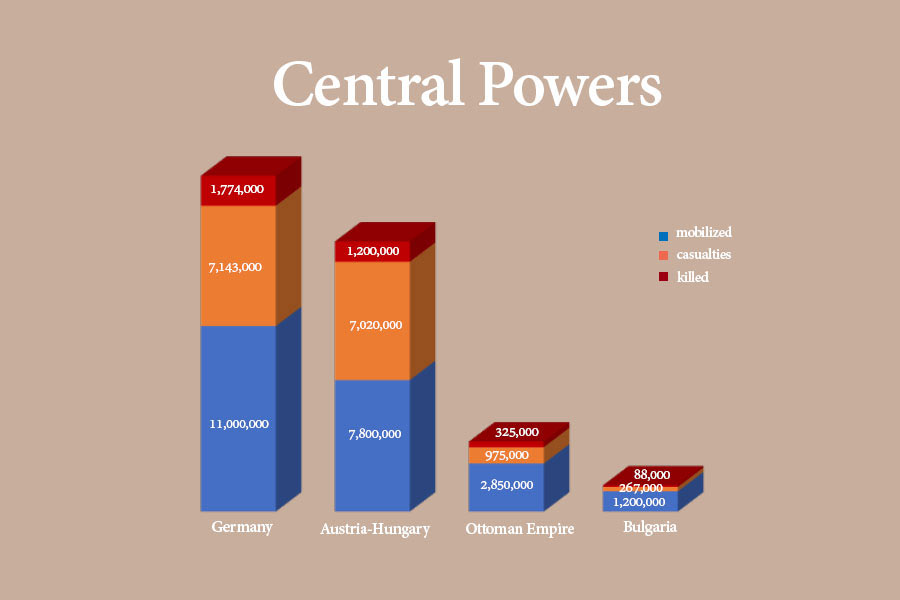Artillery

Artillery was a staple in World War I. Canons had existed for centuries, but the technology had recently advanced significantly both in terms of mobility and fire rate. The guns could fire between 8 and 25 heavy shells a minute. They launched two types of projectiles: either shrapnel or high-explosive impact rounds. It’s estimated that almost 40% of the fighting forced manned these guns.
Information via: Encyclopedia.
A Lingering Effect

During the war, the Germans alone fired 222 million rounds. That’s almost 142,000 a day. In fact, so much artillery was fired in Verdun that a 62 square mile area is still uninhabitable. Arsenic is 300 times higher in water than normal, and there are still so many buried, unexploded artillery shells that thousands of tons are dug up each year. This is estimated to continue for another 300 to 700 years.
Information via: WarHistory; NPR.
Big Bertha
Trenches

Siege warfare wasn’t left in the Middle Ages. It made a resurgence in the beginning of the war during the standoff at the First Battle of the Marne and continued for the duration for the war. They became zig-zagging, elaborate systems. The longest trench ran from the North Sea down through France.
Information via: History.
Spanish Influenza

Because trench conditions were so bad, it provided a great opportunity for disease to spread. One did: The Spanish Influenza. It began in the trenches of WWI at the end of the war, and as the soldiers filtered back home, it went on to infect almost every corner of the world. The flu was so deadly that in just two years it killed more people than the Bubonic Plague did in three.
Information via: PassportHealth.
Machine Guns

Invented just a few decades before, machine guns came a long way by the time WWI rolled around. They could fire up to 600 rounds a minute at a range exceeding two football fields. It’s estimated that one machine gun was worth 80 rifles. They were especially effective at keeping soldiers pinned down in the trenches.
War Pigeons

War Pigeons aren’t a joke. Used to carry messages, 100,000 pigeons flew during WWI with a success rate of 95%.
Information via: Telegraph.
Legendary Pilots

The Wright Brothers took their first flight in 1903. By World War I, planes were a weapon. German pilot Richthofen, known as the Red Baron, personally took down 80 planes. France’s René Fonck took down 75.
Information via: First World War.
Zeppelins

Zeppelins were not very fast, nor could they carry much. Instead, they were used to strike fear into the English. They were stealthy, often appearing at night, dropping a few bombs over London, and leaving. The bombs were rarely harmful, but functioned as a reminder to show the English people that the Germans were there.
Information via: Airships.
Lusitania

The Lusitania, a British passenger ship, was shot by a German submarine on May 7, 1915. It sank in 18 minutes. Of the 1,960 passengers on board, 1,193 people perished, including 124 Americans.
Information via: RMSLusitania.
Drafted V. Volunteered Americans

America entered the war on April 6, 1917, and it proved to be a major turning point. The U. S. needed troops, however, so Congress passed the Selective Service Act. 10 million men registered for the draft, and almost a third of that number was drafted.
Information via: History.
Private Sidney Lewis

Private Sidney Lewis of fought with Britain for 6 weeks during the Battle of the Somme, one of the bloodiest battles of the war. He was discharged from the Army after his mother proved that he had been 12 when he enlisted to the army. He was 13 when he fought.
Information via: HistoryExtra.
A Vicious Machine

This high number of German deaths by artillery alone was the norm for the war. The troops modified their trenches to be more resistant to the bombing, but they were still sitting ducks. There was not much to do to avoid artillery fire.
Information via: Encyclopedia.
Cost

The troops weren't the only thing affected by the war. The world economy was affected as well. America flourished for a decade after World War 1, with the Roaring '20s in full swing. On the other hand, Germany was hit with such a heavy depression that their money was almost meaningless.
Information via: Digital History.
Allied Powers

The Allies had a number of countries fighting on their side, most notably Russia, Britain, France, and Italy. The United States entered the war in force in 1917. The tides of the war turned. The British, French, and Americans largely fought together, while the Italians seemed to be stuck in Italy. The Russians fought a gruesome fight on Germany’s Eastern side.
Information via: Britannica.
Central Powers

The Central Powers seemed to be fighting a war on all fronts. Even so, they were on the offensive for the majority of the war. They pushed into Allied territory and prevented the Allies from being able to form a collective fighting force. Even still, they suffered heavy casualties. On average, the Germans lost over a thousand troops every day of the war.
Allied v. Central

The Central Powers put up an impressive fight. They mobilized roughly half the number of troops that the Allies did, and yet they always seemed to be on the offensive. That said, they suffered almost as many casualties. Russia and Germany deployed almost as many troops as each other. The majority of the troops from both countries would suffer some sort of casualty.
Total

At the end of the war, all that was left was a swath of countries all hurting, missing millions of troops. Untold numbers were never found again. Entire villages, homes that had stood for centuries, were destroyed. Some countries, like Austria-Hungary or the Ottoman Empire, no longer existed after the war.
 Author
Ron Winkler
Last Updated: June 26, 2025
Author
Ron Winkler
Last Updated: June 26, 2025
